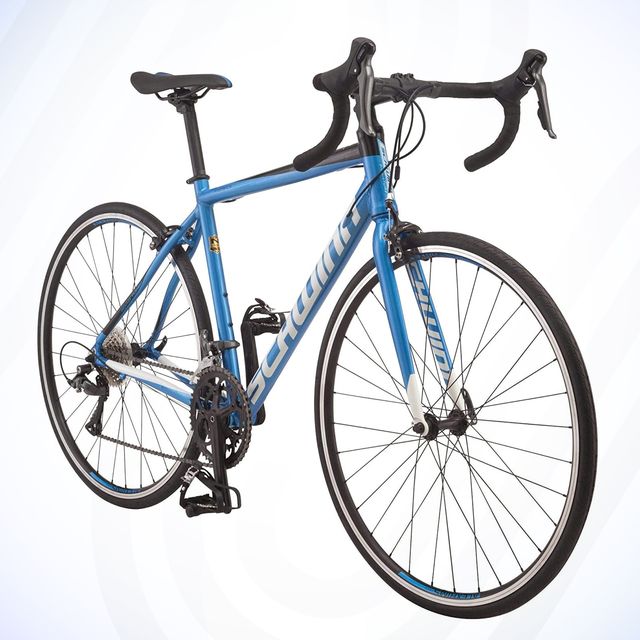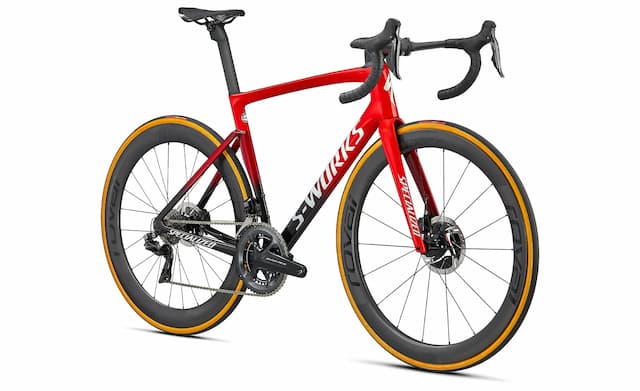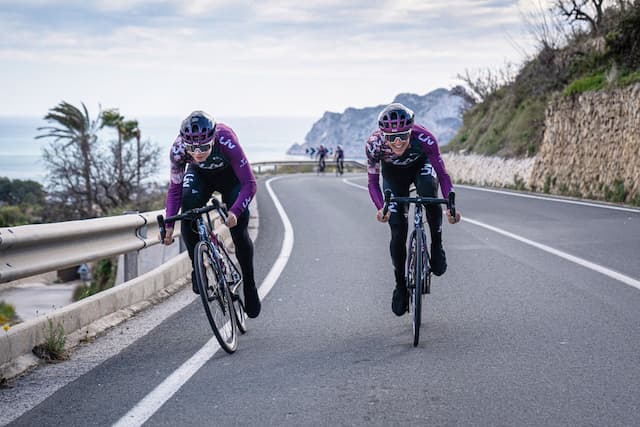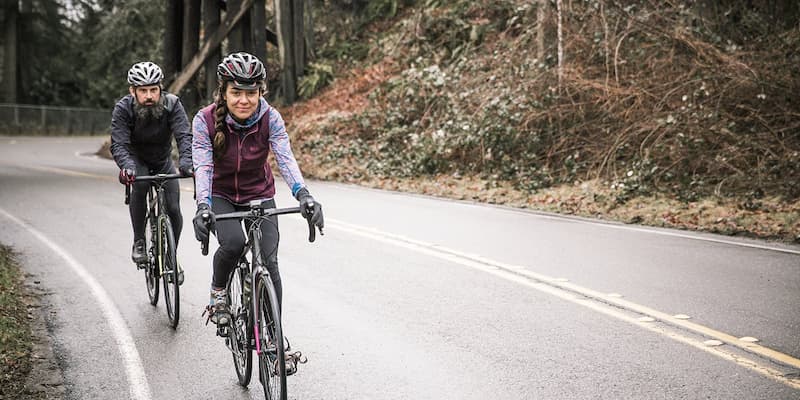For bike beginners, what is a road bike? What are the components of road bikes? Read on to find out more details.
Road bikes are bicycles made to carry you as far and as quickly as your legs can go on paved surfaces. The road is the surface that the road bike is intended to be used on, hence its name.
Table of Contents
What is a Road Bike?
A road bike is, as the name implies, a bicycle made specifically for riding quickly along paved surfaces.
Given that road bikes are commonly used in a variety of competitive cycling events, it makes sense that some cyclists refer to them as racing bikes.
Road bikes can be recognized by a number of distinctive characteristics, such as their light frames, drop handlebars, and thin, frequently slick tires.
The name “road bike” can be used to describe a variety of different bikes, all of which share several common characteristics but have slightly different purposes, such as gravel bikes, fixed gear bikes and cyclocross bikes.
Frame and Fork (or Frameset)

the vital components at the center of the bike, to which everything else is bolted. Aluminum or carbon fiber, depending on your budget, are the materials used to make more affordable road bike frames. While some upscale frames are made of titanium, older or more specialized models may also be made of steel.
Forks on bicycles with metal frames are frequently made entirely or partially of carbon fiber.
Regardless of what it is made of, it will do the same thing, which is support the rider and provide a mounting point for the other parts.
To fit their riders, frames come in a variety of sizes. The height and length of the frame adjust as these increase or decrease in size to fit the riders’ upper and lower bodies.
The frame and fork, which must accommodate all other components, will determine the largest tire sizes the bike can use, whether it has disc brakes or traditional rim brakes, and whether it can accommodate accessories like mudguards, pannier racks, or bikepacking bags.
The geometry, or dimensions and angles of the frame and fork, contributes to the overall handling qualities of the bicycle. Read our explanation of bicycle geometry here.
Wheels and Tyres
a bicycle component that makes it possible for the entire assembly to roll. The majority of road bike wheels have a specific diameter designated as “700c.” Different, more minuscule sizes may be used on bicycles that are smaller or intended for children.
While more expensive models have carbon rims, more affordable and midrange models have aluminum (‘alloy’) rims.
Hubs and rims are connected by spokes, which are typically made of steel but can also occasionally be aluminum or even carbon. A freehub, also known as a freewheel, is built into the rear hub of contemporary road bikes, where the cassette (see below) mounts.
Road bike tires, in contrast to those on other types of bicycles, are compact and lack a distinct tread pattern, or near-slick.
Treads with a width of about 23 mm, which were created to roll effectively on paved surfaces, were once common; however, in the interest of greater comfort and versatility, it’s now common to find tyres as wide as 30 mm installed.
Road bike riders prize the lightest possible wheels and tyres because they have a disproportionate impact on the handling and feel of the entire bike.
Groupset
‘The term “groupset” refers to the greasy parts that help propel your bicycle forward and also bring it to a stop. The following essential parts are typically thought to make up the groupset…
Levers (incorporating Shifters and Brake Levers)
Modern road bikes have integrated shifters, which incorporate separate brake and derailleur levers into a single unit.
They give you a variety of hand positions and are made to work with drop handlebars. The “hoods” are the tops of the levers. These offer an additional location to steer the bicycle away from the handlebars.
Crankset (or Chainset)
The cranks help the bike move forward and provide leverage. Your pedaling efforts will then be used effectively by the cassette and the size of the chainrings that are attached.
Road bike cranksets typically have two chainrings with 53 and 39 teeth (or “T”), respectively. However, it’s now typical to find a 50 and 36 combination in order to provide simpler gears. A crankset with 53/39 chainrings is referred to as a “standard double” crankset because it used to be the standard.
A “compact” chainset uses a 50/34 combination, while a “pro-compact” chainset uses 52 and 36T chainrings and provides performance that falls between the two.
Crank ratios of 50/37, 48/35, and 46/33 are offered by the newest 12-speed road groupsets from SRAM.
Some road bikes designed for touring will also have a third chainring. A “triple” is a vehicle that offers a wide range of gears and is useful on very hilly terrain.
Single chainring cranksets are also becoming more and more popular. These use a single chainring, do not require a front derailleur, and provide a streamlined range of sequential gears. They are also known as 1× or “one-by” systems.
They provide a similar spread of gears but with larger jumps between each when paired with a wide cassette. Although they occasionally appear on road bikes as well, they are particularly common on gravel bikes for mixed terrain. “Super-compact” double cranksets with ratios like 48/31, 46/33, 46/30, and 43/30 are primarily used on gravel bikes.
The bottom bracket is the bearing assembly in the frame that supports the crankset.

Cassette
The collection of gears attached to the back wheel is called a cassette. They are propelled forward by the chain, using the energy you expend pedaling.
How simple it is to turn the pedals depends on the size difference between the chainring and cassette cog. There are currently a maximum of 13 sprockets per cassette. However, 11 and 12-speed cassettes are more prevalent. Bikes that cost less or are older may have significantly fewer.
Numerous sprockets allow you to pedal effectively on any surface. However, having a variety of them is just as important as having many different pieces of equipment. The term “wide ratio” refers to a cassette’s large gap between the largest and smallest sprocket. It will therefore be suitable for both riding very quickly and moving very slowly.
Modern road bikes typically come with 11-28, 11-30, 11-32, or 10-33 cassettes, though there are many other options. The cassette ratio is expressed as a range of tooth counts.
Chain
A road bike chain joins the cranks to the cassette with the help of links, rollers, and rivets. Its width matches the quantity of sprockets and transfers power between them. Keep it lubricated and clean.
Derailleurs (or Mechs)
These mechanisms handle gear changes. The majority of the shifters’ controls are Bowden cables, which transmit the force required to move them in one direction directly, with a spring providing movement in the opposite direction.
While the front derailleur moves the chain from one chainring to the next, the rear derailleur moves the chain across the cassette sprockets.
Instead, more expensive bicycles might have electronic derailleurs. These depend on battery-operated servo motors to perform the labor-intensive tasks. They have similar mechanical design but are controlled wirelessly or by electronic cables.
Brakes
Rim brakes, also known as caliper brakes, or disc brakes are typically found on road bikes. Rim brakes are high-mounted bicycle devices that directly clamp the wheel rims to slow you down.
Disc brakes are mounted nearer to the bicycle’s axles and use a different rotor that is connected to the hub as the braking surface. However, disc brakes are a little bit heavier and typically more powerful and reliable when it comes to stopping.
Read about Can You Ride Dirt Bikes on the Road?
Who Should Use a Road Bike?
Road bikes are made to propel riders at high speeds with the least amount of effort. Because of this, road bikes are a popular choice among cyclists.
The use of a road bike is advantageous for cyclists who participate in road bike races and comparable events. It might be possible to compete in a road race on a mountain bike, but you’d be at a significant disadvantage.
Road bikes’ speed is also appealing to commuters and casual cyclists. As a result, you’ll be able to spend a little longer in bed each morning because your commute to work will be quicker and less taxing.
Unquestionably, one of the best types of bikes you can select if you live in a city is a road bike. A fixed gear bike, as opposed to a road bike, will probably serve you better if you prefer a bike that requires little maintenance.
You should think about the ergonomics that each road bike offers if you’re considering one.
Do you desire a road bike with an aggressive riding position that improves aerodynamics? Or a road bike with an upright, more relaxed riding position for quicker, more comfortable commutes?
Lastly, a hybrid bike or a gravel bike may be more appropriate if you enjoy riding both on and off-road trails.

How Much Does a Road Bike Weigh?
The table below includes the weight and cost of 15 randomly chosen road bikes, and its purpose is to show how much the typical road bike weighs.
The chosen bikes were located on various US and EU websites.
I made an effort to maintain the readings at the medium road bike frame size of 54-55cm. Only one size of weight was provided by a few brands, so the frame sizes are listed along with the corresponding weight.
The average weight of a road bike is 20.7lb (9.4kg) when the weights of the 15 randomly chosen road bikes are added together.
The majority of road bikes will weigh between 8kg and 11kg, and the average weight of a road bike is approximately 20.7lb (9.4kg). Both entry-level and expensive road bikes are included in this range.
How Much Does a Road Bike Cost?
The information below will give you a general idea of the cost of your average road bike if you’ve been considering buying a new one but are curious about how much a road bike costs.
I chose my arbitrary examples from more specialized online retailers. The vast majority of the bicycles listed below are mid-level road bikes for serious road cyclists.
According to the data, the typical cost of a mid-high level road bike is $2,475 (or £1,800).
Expect to pay between $850 (£615) and $6,335 (£4,600) for a new road bike (mid-high level).
Low-end road bikes can be bought for as little as $350 (£250), but they have subpar parts that aren’t built to last. On the other hand, you can anticipate paying upwards of $13,750 (or pound;10,000) if you’re looking to purchase a high-end road bike.
Getting the Correct Frame Size
Up to six different frame sizes are offered for the majority of road bike models, and oftentimes, women-specific frames are also available. Choosing the proper frame size for your body geometry is crucial. A frame that is the proper size for you will be noticeably more comfortable and have better handling characteristics than one that is either too large or too small.
Frame sizes can be specified using either centimeters, which measure the seat tube’s length, or the more standardized XS–XL size range. Be aware that even if the frame size is the same for men and women, the frames are not the same. Since women typically have a shorter torso and shorter arms than a man of the same height, their frames will be shorter along the top tube.
How do you determine which frame size is best for you? Although many bike shops, including REI, use a fitting system or calculator like the Bike Fit Kit to determine a suitable frame size for you, an experienced bike salesperson can frequently tell by looking at your proportions.
To make a more informed frame size recommendation, your bike salesperson should also inquire about your past riding history, flexibility, riding style, and intentions. Although the standover clearance over the top tube is crucial, the length of the bike—which affects the reach from the seat to the handlebars—is a more crucial size determinant.
What Accessories Are Recommended When Using a Road Bike?
To make your time cycling as comfortable and productive as possible, it’s never a bad idea to spend some money on a few accessories.
Bicycle locks, lights, and mirrors allow for the highest level of safety and security because road bikes are most frequently used in crowded cities.
Bottle cages and a puncture repair kit are typically included in road bike owners’ emergency kits.
Having to walk your bike long distances in cycling shoes is not ideal, so you should at the very least be able to change a flat tire when you need to
A cycling computer/GPS will be a great investment if you enjoy the competitive aspect of cycling, whether it be against yourself or other cyclists.
You can monitor your fitness and keep track of route times, distances, cadence, and power using a cycling computer.
So, What is a Road Bike?
The primary purpose of a road bike is to travel quickly over paved terrain. Road bikes typically have drop handlebars, relatively narrow slick tires, and position the rider so that their bum is higher than their hands.
Components on a typical road bike haven’t changed all that much in more than a century. We won’t hold it against you, though, if you didn’t use that time to familiarize yourself with the appropriate terminology.



